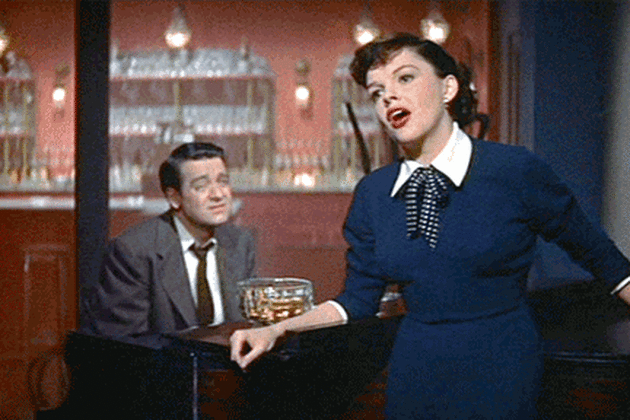A Star is Born (1954)
- Soames Inscker

- May 20
- 4 min read
Updated: Jun 7

Among the various incarnations of A Star Is Born—a story told across decades of Hollywood history—the 1954 version stands as arguably the most emotionally powerful and artistically accomplished. Directed by George Cukor and starring Judy Garland in a triumphant comeback role opposite James Mason, the film is both a dazzling showbiz musical and a devastating character study about fame, self-destruction, and personal sacrifice.
Although it faced production and post-release challenges, this version has come to be seen not only as a high watermark of 1950s cinema, but also as one of the finest musical dramas ever made.
Plot Summary
The film follows Esther Blodgett (Judy Garland), a talented young singer performing in a nightclub, who catches the eye of washed-up, alcoholic movie star Norman Maine (James Mason). Despite his faltering career and erratic behaviour, Norman recognizes Esther’s potential and introduces her to the right people in Hollywood.
Under a new screen name—Vicki Lester—Esther ascends to stardom, winning critical acclaim and the adoration of audiences. Meanwhile, Norman’s career continues its downward spiral. As Esther’s fame rises, Norman becomes consumed by jealousy, self-loathing, and alcohol. Their love story becomes increasingly strained, culminating in one of the most tragic endings in classic Hollywood cinema.
Performances

Judy Garland as Esther Blodgett / Vicki Lester
This film was Garland’s first starring role in four years, and it is unquestionably the performance of her career. Her emotional range is breath-taking—moving from wide-eyed hope to joy, to crushing heartbreak with raw vulnerability. Her singing is electrifying, particularly in numbers like "The Man That Got Away" and "Born in a Trunk", which showcase not only her vocal power but her profound interpretative skill.
Garland’s performance is infused with autobiographical resonance: she, like Esther, had known the cruelty of fame, public scrutiny, and personal struggles. That knowledge gives her portrayal a heart-breaking authenticity.
James Mason as Norman Maine
Mason brings depth and dignity to the role of Norman. While Fredric March’s 1937 Norman was more classically tragic, and later iterations leaned into cruelty or narcissism, Mason’s take is empathetic and complex. He’s not a villain, but a broken man—self-aware, ashamed, and desperate for redemption. Mason avoids melodrama, delivering a performance of quiet devastation.
Together, Garland and Mason have magnetic chemistry, creating a relationship that is both passionate and unbearably sad.
Direction and Cinematic Style

George Cukor, known for his work with strong actresses (Garbo, Hepburn, and later Audrey Hepburn in My Fair Lady), was the perfect choice for this project. His direction is elegant, restrained, and deeply actor-focused. He allows the performances to breathe, especially Garland’s, while surrounding them with a vibrant and detailed Hollywood milieu.
The film is one of the earliest major uses of CinemaScope, and Cukor uses the wide frame effectively—not for spectacle, but for intimacy. From studio sound stages to elegant interiors and crowded premieres, the film immerses viewers in the backstage world of show business without glamorizing it.
Music and Score

The musical numbers are integrated into the narrative in a way that deepens character development and emotional stakes. Highlights include:
"The Man That Got Away" – Arguably Garland’s greatest on-screen performance, delivered with smouldering emotion in a single, uninterrupted take.
"Born in a Trunk" – A lengthy but dazzling musical sequence added by the studio to showcase Garland’s talents. Though not essential to the story, it’s a tour de force.
"Lose That Long Face" – A bittersweet contrast between showbiz cheer and personal anguish.
Ray Heindorf’s orchestration and the songs by Harold Arlen and Ira Gershwin elevate the film to operatic levels.
Themes and Subtext
At its core, A Star Is Born is a tale of dual trajectories: the ascent of one star and the fall of another. But it’s also a powerful meditation on:
Fame and its cost – The film lays bare the paradox of Hollywood success: the adoration of millions juxtaposed with the loneliness of personal loss.
Addiction and self-worth – Norman’s alcoholism is portrayed with unusual sensitivity for the era, showing how talent can be undone by emotional fragility and societal pressure.
Female agency – Esther’s rise is marked by talent and determination, not manipulation. Despite the tragedy around her, she maintains her dignity and integrity.
Redemption and sacrifice – The ending, with Norman’s suicide and Esther’s final declaration—“This is Mrs. Norman Maine”—is both crushing and strangely empowering.
Historical Context and Restoration
The film was heavily edited after its premiere, with nearly 30 minutes cut by Warner Bros. to allow for more screenings per day. For decades, those scenes were considered lost.
In 1983, film historian Ron Haver oversaw a partial restoration, incorporating recovered footage and production stills with the original soundtrack. This restored version, now the most commonly seen, revived critical appreciation and brought the film closer to Cukor’s vision.
Conclusion
A Star Is Born (1954) is more than just a musical or a love story—it’s a deeply human tragedy about the cost of success, the fragility of self-worth, and the enduring power of performance. Anchored by Judy Garland’s searing, unforgettable turn and James Mason’s nuanced support, the film is both a love letter to and a critique of the entertainment industry.
Despite production challenges and studio interference, the film’s emotional core remains intact, resonating across generations. For lovers of classic cinema, musicals, or emotionally rich drama, this is a masterpiece that deserves its legendary status.
A soaring and heart-breaking triumph—perhaps the most affecting version of this oft-told tale.





